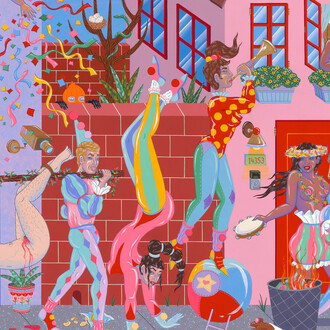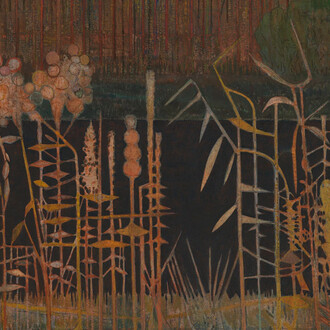Nonaka-Hill is pleased to present Kyoko Idetsu’s first Los Angeles solo exhibition What can an ideology do for me?, opening Saturday, July 27 from 6 – 8pm. The artist will be present.
The paintings of Kyoko Idetsu emerge from daily life, which is arguably a daisy chain of minor stories. They are inevitably punctuated by more important stories that lodge into our memories and justify our picture frames, our resumes, and our obituaries; but Idetsu prefers to mostly focus on the smaller observed events, elaborating them into paintings with outsized emotional and visual weight. We might call this anecdotal expressionism, a school of painting limited to herself. Or we might describe it as a painting diary, albeit mingling the visual narrative devices of manga, television, and film; which heightens her ability to jump cut and flashback, to move in time and space across the picture plane. This animates her painted anecdotes, infusing them with unique emotional registers that underlie daily domestic life.
Yes, the language of robots is numbers, but does an ideology teach children to study?
(Kyoko Idetsu – What can an ideology do for me?, 2024)
It is not a coincidence that Idetsu literally makes her paintings at home––amidst the mild chaos of raising children and tending to domiciliary routine. One assumes this is partly an economic decision, as many painters are wont to make, but it has significance: as an immersive experience––intended or not––that influences her paintings, at least to a certain degree, into a certain appearance. Much of this is attributed to her distinctive touch with color, drawing, and composition. She relies heavily on local hue (the color of objects under flat white light without shadow or secondary light sources), which entails, for example, that a truck is decidedly cobalt blue and pavement is emphatically gray. She even depicts bicycle spokes with true fidelity––in low-lustre metallic paint. Each object is imbued with a color’s weight and substance, all the while avoiding the optical tricks of realism that would otherwise deaden its immediacy.
If Pierre Bonnard once said that “drawing is feeling. Color is an act of reason” the same could be said of Idetsu’s use of line and shape. Oriented towards innocent versions of forms, her concerns for traditional perspective and anatomy are laissez-faire––for the exception of compositional structure and harmony, which are, like in all good painting, tightly wound. In her more complex works, they have a kaleidoscopic quality: every object can suddenly open into a vignette and every face can become a projector screen. Which is what transpires in her painting Let me indulge in idle chatter, 2024, where a couple seated before a precarious single tower of burgers, constructs a story observing an uninhibited diner nattering on at a local restauran.
Let me indulge in idle chatter might resemble filmic montage as much as other paintings might invoke manga––or both; but either way, these dynamic mechanisms stand in contrast to Idetsu’s quotidian content, which amounts to habitual daily life; and in the thick of routine, days can blend into one another, spawning slight variances of the same stories. Breaking from this cross-fading of minor events, Idetsu focuses on anecdotes that stick out to her, those that are elevated, or become elevated for having been painted. She derives these vignettes from the news or the books she reads; or from her personal life, ranging from ancestral wisdom or a story a random acquaintance had shared. Psychotherapist and writer Thomas Moore wrote that storytelling (and retelling), is care for the soul, that “it helps see the themes that circle in our lives.” In visual form, Idetsu does just that, reflecting the unacknowledged care that is invested in our social bonds and in ourselves. “While I was reading a book about the war in a cafe, the women sitting next to me were very excitedly complaining about their husbands. My daughter loves big food shows and records them to watch”.
The artist occasionally supplies these stories in writing alongside her paintings (often in the gallery checklist, sometimes directly on the wall), as if they were appetizers or aperitifs to the viewer’s experience; and they seem to be equally apt for casual conversation amongst her friends and family. Such as the anecdote depicted in Part-time job (smartly), 2024, in which a friend of Idetsu’s reminisces (amusingly or not) on rote, but incentivized, factory work. Far from a cataclysm, but tedious nonetheless, the artist lends it an endearing patina. This is done in part by stacking the narrative story portals, ending on the moment in which the tale of appreciation is based. Yet the heavy lifting is done here, as in all of her paintings, with her unfussy playfulness.
A friend of mine worked part-time at a candy factory when he was younger and was praised by the employees for his very smart job of catching the rice cakes coming out of the machine.
(Kyoko Idetsu – Part-time job (smartly), 2024)
One might be tempted to call her style ‘faux-naive,’ but this holds little water considering the raft of 20th century artists who set this precedent outside the realm of ‘self-taught’ art: Jean DuBuffet, Florine Stettheimer, Enrico Baj, and A.R. Penk to name a few, spent the bulk of their careers finding and re-finding that “innocent” place through which they could make things without the baggage and appearance of technical facility. While Idetsu’s paintings do not bear resemblance to these artists, they have a shared commitment to the freedom of unconditioned visual expertise. That is to say, her style commits to what is necessary for her content and emotions. In this sense, one might describe her work as pragmatic naïveté, to the extent that naïveté could be applied to the prodigious skill and quality of her painting.
Kyoko Idetsu (b. 1986 Tokyo, Japan) lives and works in Tokyo, Japan. Selected solo exhibitions include Slow to act, Echigo-Tsumari Satoyama Museum of Contemporary Art, Niigita (JP); Kyoko Idetsu, Crèvecoeur, Paris (2023); I want to wear a warm sweater., Bridget Donahue, New York (2022 - 2023); He had no choice but to do so., Brulee (Shunsuke Imai Studio), Tokyo (2020); Emotion, ArtCenterOngoing, Tokyo (2019); Draw me a beautiful picture to hang in my house., Lucky Happy Studio, Tokyo (2017); Milky way, ArtCenterOngoing, Tokyo (2017); The landscape I saw the other day, ArtCenterOngoing, Tokyo (2012). Selected group exhibitions include Burning down the house: rethinking family, Kunstmuseum St. Gallen (CH) (2024); The postmodern child part II, Busan Museum of Contemporary Art, Busan (KR) (2023); Presence in the pause: interiority and its radical immanence, Bemis Center for Contemporary Art, Omaha (NE) (2023); Kyoko Idetsu and Leo Okubo, Lavender Open Chair, Tokyo (2021); Fictions of everyday life, Akibatambi 21, Tokyo (2021); Natsuyasumi, Nonaka-Hill (2021); Teratotera Festival 2015, (open production), Tokyo (2015); The best view from here, Tokyo Metropolitan Art Museum, Tokyo (2021)
















